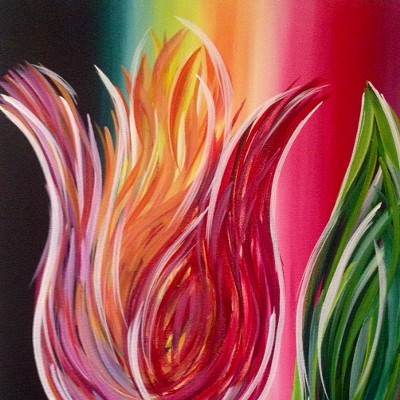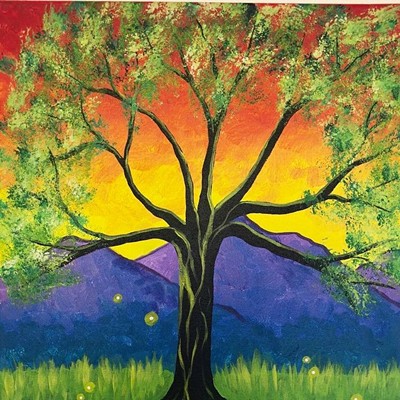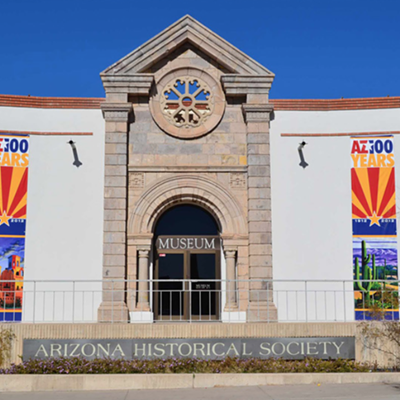Emerging out of a decade of high-minded abstract-expressionism, the young Johns, at 28, was a breakthrough artist who (along with Robert Rauschenberg) pushed art into its next frontier. He returned to the canvas figurative objects of the most ordinary sort--targets, flags, numbers--and painted them in such arresting and visually lush ways that they inevitably challenged ideas about the relationship between art and reality. What he did was called pop, but what it looks like nowadays is classical modernism.
Johns' show of 60 prints at the UA Museum of Art is a rare opportunity for Tucsonans to see this modern master's work. (It's one of a number of great shows in midtown that won't be up too much longer--see below.) Curated by the museum's Peter Briggs, the show focuses exclusively on the painter's prints--the virtuoso lithographs and intaglios that won him as much acclaim as his paintings after 1960. There's no other word but "gorgeous" for their lush colors, fine lines and flawless compositions.
"The Seasons: Spring, Summer, Fall, Winter," 1987, is a series of four colored intaglios, crowded with human figures in cramped urban spaces. Nature nonetheless burrows into this city's nooks and crannies. A patch of blue or white or gray overhead is the sky; snowflakes spatter winter; raindrops hurl diagonally across spring. Seasonal colors flow from summer's leaf green to autumn's golden orange, and the shadowy figure moves across the images, a stand-in for time passing.
Johns, says Briggs, often re-visited his plates, and on an adjoining wall, you can see Johns' seasons in a different mood and year. "The Seasons," 1989, uses the same four plates, but this time printed together as one work; summer instead of spring starts the sequence, and their colors have given way to a calligraphic black, white and gray.
Especially disarming are Johns' numbers, gathered in painterly grids in "0-9," 1963, and in "Numbers," 1967. The famous flags are in attendance as well: "Targets," 1968, is a litho with a flag in green and blue stripes. "Flags II," a litho made two years later, takes the same plates and doubles the flags, rendering them as jiggly drawings colored pink, green and orange.
In "Ocean," a 1996 lithograph, Johns honors his friend and sometime collaborator, the great mid-century choreographer Merce Cunningham, picturing him as both a young dancer and an old man. It says something of Johns' stature that last week, one of America's pre-eminent writers, John Updike, was spotted gazing at Johns' work.
Across the way at the Center for Creative Photography, another show challenges the very idea of the kind of "high art" that gifted modernists like Johns, Cunningham and Updike are still creating. The post-modernist Evidence Revisited: Larry Sultan & Mike Mandel raises the question of what art is, the same challenge Johns launched so long ago. As its title suggests, the show re-visits a project that the then-young artists Sultan and Mandel undertook in 1974.
The pair traveled the country, trolling through photographic archives of the most prosaic sort--like a coal industry repository and an insurance headquarters--and the most grisly sort, like police files. What, they wondered, would workaday photos from these places look like, divorced from their context and setting? Would they be art?
Well, not exactly. Interesting, perhaps; challenging, sometimes, but, alas, boring as well. It's especially hard to appreciate them if you go, as I did, after studying the extravagant Johns beauties. There are pictures of a parachute being tested just above the ground, of hands getting measured on a grid, of a car being set afire. It is entertaining to look at, say, men in ties peering into a fan box, or a similar guy with his head in a plastic bag, and to speculate on their meanings and read the accompanying letters the two young artists sent to bureaucrats asking for permission to forage in their files.
In its first incarnation, the show created a sensation and touched off debates about the nature of art and the value of "found" photography. Certainly at its most ordinary level, the collection evokes a time period, especially of those long-ago, buttoned-down dads going dutifully about their business. At another level--of art?--it hints obliquely at the idea that somehow all of us--insurance agents, product testers, everybody--are just unwitting players in a script not of our making.
If Evidence calls up a kind of melancholy of lost time and lost lives, the installation Purgatorio at Joseph Gross Gallery explodes with full-throttle passion. Michael Cajero and Alice Leora Briggs have pooled their considerable talents to create a hellish vision of purgatory, filled with Cajero's screeching papier-maché figures and Briggs' industrial-inferno painted drawings. Briggs frames the agony with a giant walk-through jail in silver paint and newsprint.
Some figures from Cajero's previous shows have found their way into this tortuous limbo. His baying hounds from last year's "Diana" greet visitors at the entrance ramp; an old man wearily slumps in a nursing home wheelchair, a relic of an old-age show at the Tucson Pima Arts Council a few years back. Likewise, Briggs' cells recall the installation she made at Tucson Museum of Art three years ago.
Both Briggs and Cajero are technical whizzes, Briggs with her masterly drawings and paintings, Cajero with his burned and twisted arte povero sculptures. Individually they're both wild artists of the strange and shocking; together, they've conjured up a terrifying art of conflagration.
Finally, Claire Campbell Park, one of Tucson's finest fiber artists, returns our art tour to a meditative calm. Her wall hangings at Obsidian Gallery are superbly woven; their simple bands of horizontal colors suggest the landscape. "Zebra on the Serengeti" is a collection of browns, green earth and sky blue, while "Flathead Lake" layers the many blues of water and sky in a stately series of color blocks. In their sophisticated use of color and simple composition, Park's weavings take us right back to the Jasper Johns heyday, recalling the meditative beauty of the paintings of Mark Rothko.














